Moroccan Desserts and Sweets You’ll Fall in Love With
Morocco isn’t just famous for its aromatic tagines, colorful souks, and desert landscapes — it’s also home to an irresistible world of desserts and sweets that capture the country’s essence in every bite. From honey-drenched pastries to almond-filled delicacies scented with orange blossom water, Moroccan desserts and sweets are a delicious reflection of the country’s diverse cultural heritage and warm hospitality.
Across Morocco, sweetness is more than a taste — it’s a symbol of welcome, generosity, and celebration. Whether shared during festive occasions like Ramadan and Eid, offered to guests alongside a glass of freshly poured mint tea, or enjoyed at the end of a family meal, desserts hold a special place in Moroccan daily life. Each region brings its own flair: Fes is known for its intricate almond pastries, Marrakech for its fragrant honey treats, and the southern oases for their date-based confections.
What makes Moroccan desserts truly unique is their use of natural, wholesome ingredients — almonds, sesame seeds, honey, dates, orange blossom water, and spices like cinnamon and anise — all combined with centuries-old techniques passed down through generations. The result? A perfect harmony of textures and aromas: crispy, chewy, nutty, and floral all at once.
In this guide, we’ll take you on a journey through Morocco’s most beloved traditional sweets — from the iconic Chebakia and Kaab el Ghazal to delicate M’hanncha and Sellou — and explore how these timeless recipes continue to bring people together. Get ready to discover why Moroccan desserts and sweets are more than just food — they’re a true celebration of life, love, and culture.
The Sweet Side of Moroccan Culture
In Morocco, desserts are not merely an afterthought to a meal — they’re woven into the fabric of daily life, celebration, and tradition. The country’s approach to sweetness tells a story of history, hospitality, and harmony, where every pastry, cookie, and syrup-drenched bite reflects centuries of cultural exchange and artistry.
A Symbol of Generosity and Celebration
In Moroccan homes, serving sweets is an act of generosity and respect. When guests arrive, they’re often greeted with a silver tray of Moroccan desserts and sweets accompanied by a pot of hot, frothy mint tea — the true symbol of hospitality. From weddings and religious holidays to family gatherings, desserts play a key role in bringing people together. During Ramadan, for example, families gather to break their fast with dates and Chebakia, a honey-coated sesame cookie that embodies both comfort and celebration.
A Blend of Influences and Ingredients
The rich history of Moroccan cuisine is mirrored in its sweets. Centuries of Arab, Berber, Andalusian, and French influences have created a dessert repertoire that is both diverse and harmonious. Almonds, honey, and orange blossom water — staples of Arab-Andalusian cuisine — blend seamlessly with Berber traditions of using barley, dates, and natural sweeteners from the land. French colonial influence later introduced techniques like puff pastry and custard, giving rise to a new generation of Moroccan patisseries that merge local flavors with European flair.
Nature’s Sweet Palette
Unlike many modern desserts loaded with refined sugar, traditional Moroccan sweets rely on natural ingredients that highlight Morocco’s agricultural bounty. Honey replaces artificial syrup; almonds and sesame seeds add depth and crunch; orange blossom and rosewater perfume each creation with subtle floral notes. The balance between sweetness, nuttiness, and fragrance gives Moroccan desserts their unforgettable character — satisfying the palate without overwhelming it.
A Ritual of Connection
Eating dessert in Morocco is not just about indulgence — it’s a ritual of connection. Friends gather around a pot of tea, sharing stories and laughter while savoring Kaab el Ghazal or Ghriba. The act of sharing sweets symbolizes friendship, unity, and respect. It’s this spirit — the joy of giving and receiving — that makes Moroccan desserts and sweets a true embodiment of the country’s warm-hearted culture.
Must-Try Traditional Moroccan Desserts
Morocco’s dessert culture is as diverse as its landscapes — from the snowy peaks of the Atlas Mountains to the sandy dunes of the Sahara. Each sweet treat tells a story, shaped by history, celebration, and the rhythm of daily life. Here are some of the most beloved Moroccan desserts and sweets that every traveler should try.
1. Chebakia (Honey-Coated Sesame Cookies)
Among Morocco’s most beloved sweets, Chebakia stands out for its intricate flower shape and irresistible flavor. This golden pastry is first deep-fried until crisp, then soaked in warm honey and generously sprinkled with sesame seeds.
The dough, delicately scented with anise, cinnamon, and orange blossom water, creates a fragrance that fills every Moroccan kitchen during festive times. Traditionally prepared for Ramadan, Chebakia carries deep cultural meaning — symbolizing unity, sharing, and joy after a day of fasting.
Served alongside harira soup or a glass of sweet mint tea, it’s more than just a dessert — it’s a moment of comfort, celebration, and pure Moroccan hospitality in every bite.
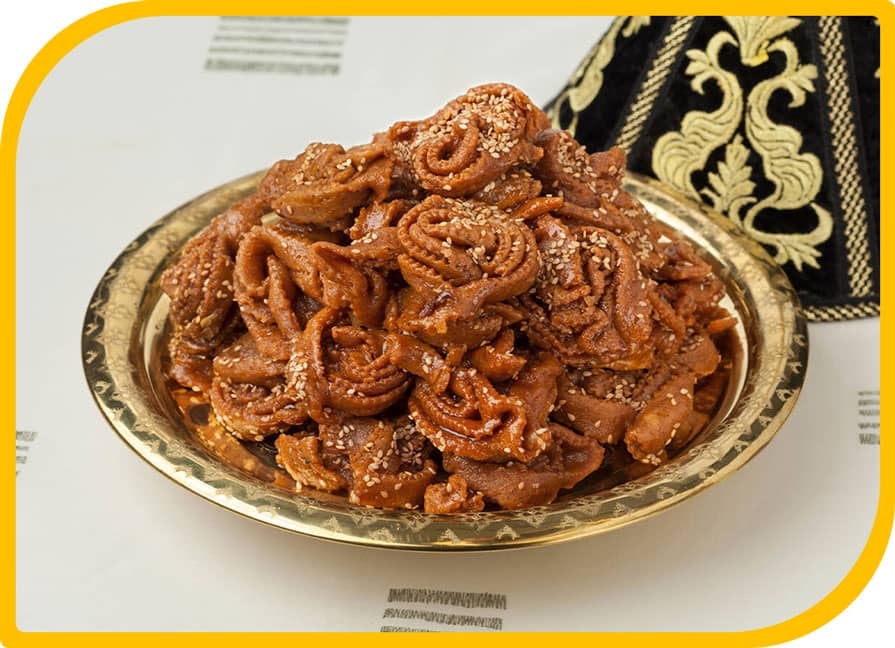
2. M’hanncha (The Serpent Cake)
Translating to “the snake” in Arabic, M’hanncha is a show-stopping Moroccan dessert that impresses with both its look and taste. Made from filo pastry rolled around a rich almond paste flavored with orange blossom water and cinnamon, it’s coiled into a spiral resembling a snake.
Once baked to a golden crisp, the pastry is dusted with powdered sugar and sometimes garnished with crushed almonds or pistachios. Its layers are delicate and flaky, encasing the soft, nutty filling that melts in your mouth with each bite.
Often served during special occasions or as a centerpiece at family gatherings, M’hanncha is more than dessert — it’s a piece of edible art that captures the creativity, patience, and precision of Moroccan patisserie.
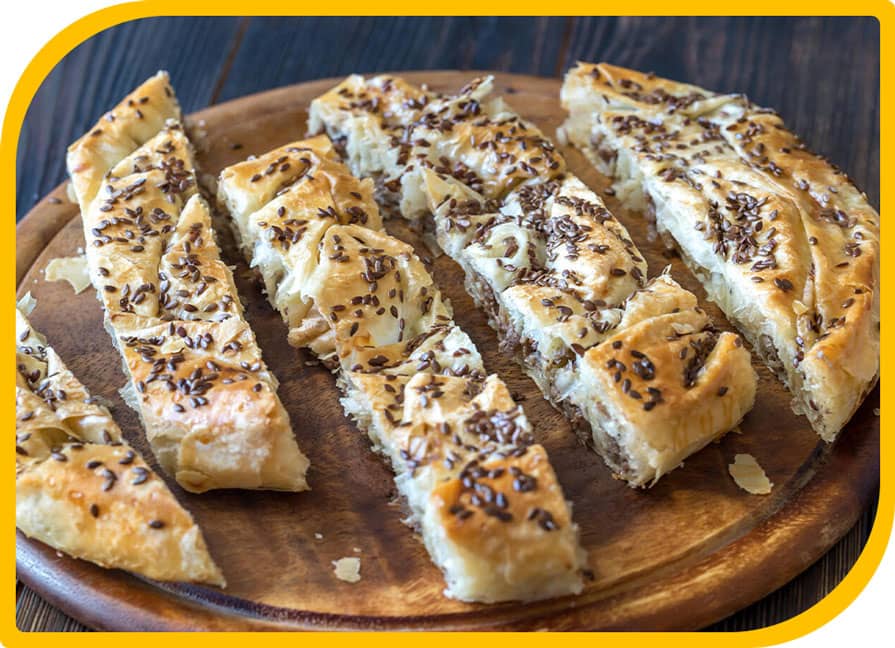
3. Ghriba (Moroccan Shortbread Cookies)
Ghriba are Morocco’s most beloved tea-time cookies, cherished for their crumbly texture and melt-in-your-mouth goodness. Made with almonds, coconut, sesame, or flour, these shortbread-style cookies are simple yet deeply comforting.
Their signature cracked surface forms naturally as they bake, giving them a rustic, homemade charm. Lightly sweet and often dusted with powdered sugar, Ghriba pair beautifully with Moroccan mint tea or strong Arabic coffee.
Each region has its own variation — from Ghriba Bahla, made with flour and butter, to Ghriba Bzouka, rich with almonds and orange blossom water. Whether served during holidays or casual gatherings, these cookies embody Morocco’s warmth and everyday hospitality.
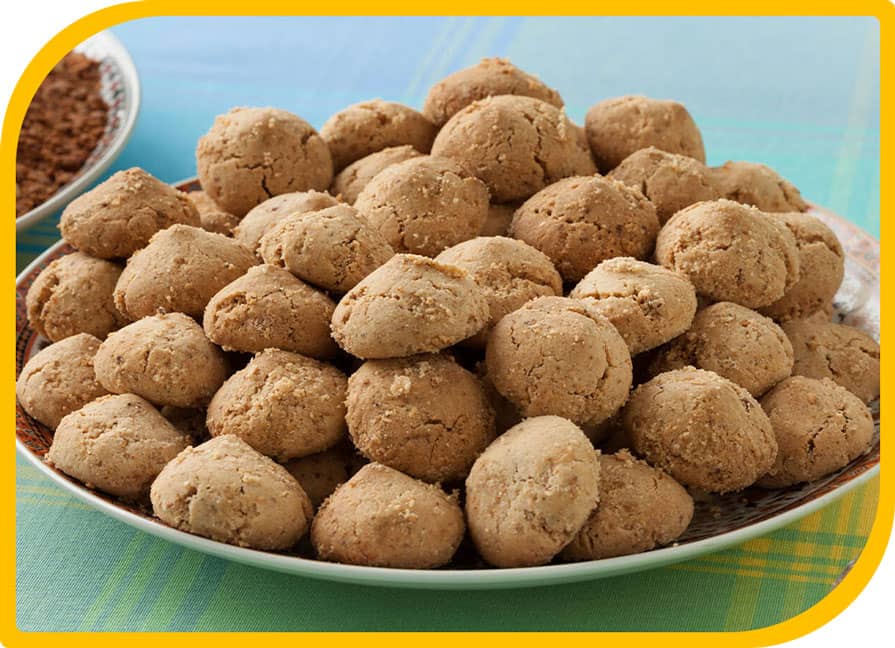
4. Sellou (Sfouf)
Sellou, also known as Sfouf or Zamita, is a rich, nourishing Moroccan sweet that’s both delicious and energizing. Made from roasted flour, almonds, sesame seeds, and honey, it’s traditionally prepared during Ramadan and Eid celebrations.
The mixture is ground and blended into a crumbly, nutty paste, sometimes topped with more almonds or powdered sugar for decoration. Its deep, toasty flavor and buttery texture make it a comfort food that Moroccans associate with home and tradition.
More than just a dessert, Sellou is known for its energy-boosting qualities — perfect after fasting or during long celebrations. Served in elegant bowls with mint tea, this sweet captures the warmth, nourishment, and festive spirit of Moroccan hospitality.
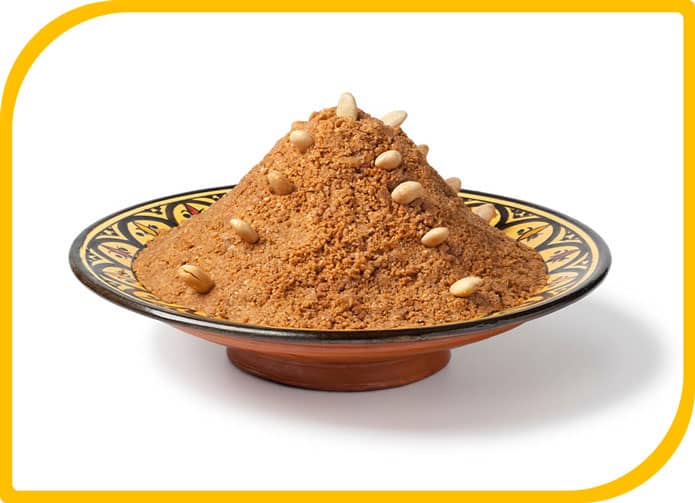
5. Kaab el Ghazal (Gazelle Horns)
Kaab el Ghazal, known as gazelle horns, is one of Morocco’s most elegant and symbolic desserts. These delicate crescent-shaped pastries are filled with a smooth almond paste, flavored with orange blossom water and a hint of cinnamon.
Each piece is carefully hand-shaped to resemble a gazelle’s horn — a symbol of beauty and grace in Moroccan culture. Once baked, the pastry becomes slightly crisp on the outside yet tender inside, releasing its nutty, floral aroma with every bite.
Traditionally served at weddings, Eid celebrations, and family gatherings, Kaab el Ghazal represents refinement and hospitality. Paired with mint tea, this sweet treat embodies the timeless artistry and generosity of Moroccan dessert traditions.
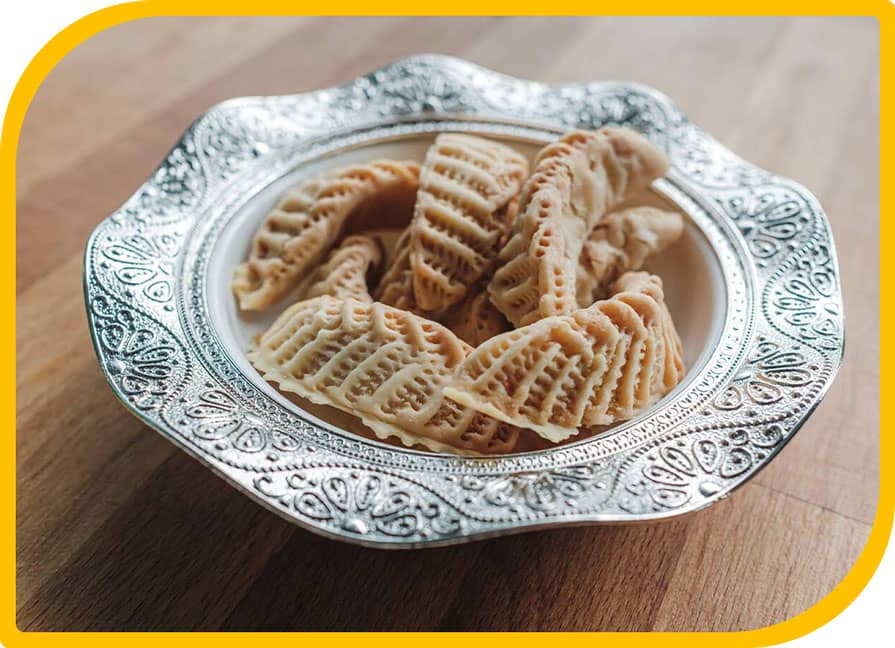
6. Fekkas (Moroccan Biscotti)
Fekkas are Morocco’s answer to biscotti — crisp, twice-baked biscuits that combine simplicity with irresistible flavor. Made from a dough of flour, sugar, eggs, and anise seeds, they’re often enriched with almonds, sesame seeds, or dried fruits for extra texture.
Once baked, the dough is sliced into thin rounds and returned to the oven until golden and crunchy. The result is a sweet, aromatic biscuit that pairs perfectly with mint tea or coffee, making it a staple in Moroccan households.
Fekkas are enjoyed at family gatherings, celebrations, and tea times, symbolizing everyday joy and warmth. Their long shelf life and satisfying crunch make them a favorite treat to serve guests or gift to loved ones — a small but cherished taste of Moroccan hospitality.
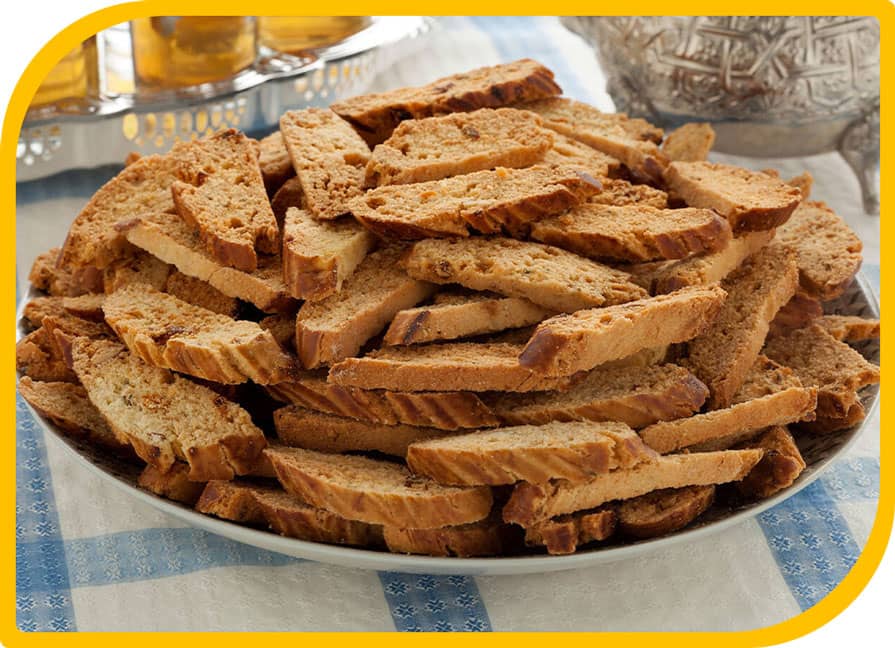
7. Baghrir (Moroccan Pancakes)
Nicknamed “thousand-hole pancakes,” Baghrir are light, spongy crepes made from semolina flour. Their porous surface absorbs melted butter and honey, creating a deliciously soft and syrupy bite. Often served for breakfast or afternoon tea, Baghrir is a comfort food that transcends regions and generations. Whether eaten plain or topped with almonds and dates, these pancakes showcase the beauty of Moroccan simplicity.
Each of these desserts reflects the artistry and heart of Moroccan cuisine. From festive pastries to everyday cookies, they remind us that sweetness in Morocco isn’t just a flavor — it’s a philosophy rooted in generosity, joy, and tradition.
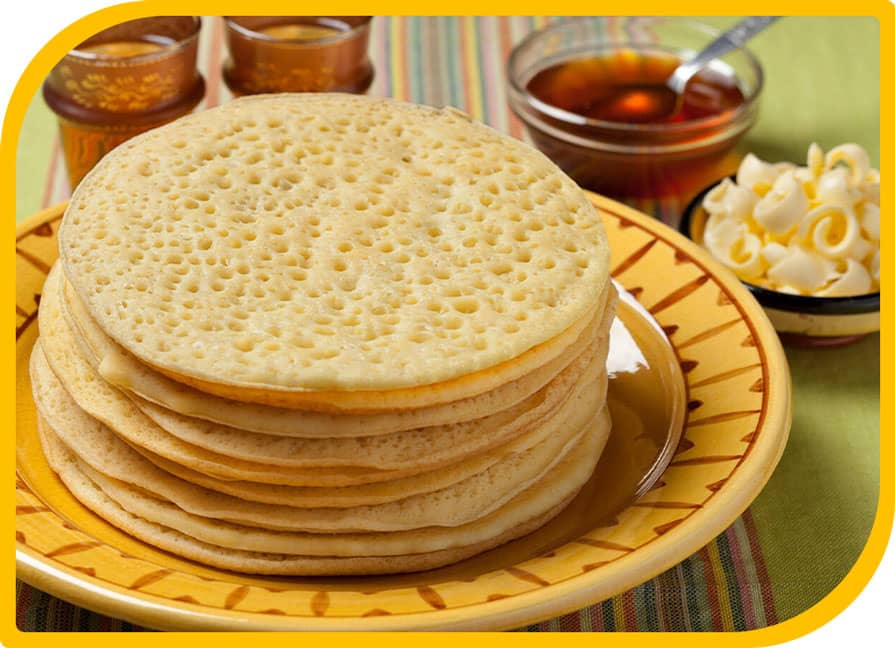
Taste Morocco’s Sweet Side Today!
Ready to experience the irresistible world of Moroccan desserts and sweets? From honey-drizzled pastries to almond-filled delicacies, Morocco’s desserts offer a delicious gateway to its culture, history, and hospitality. Visit traditional bakeries and bustling medinas to taste Chebakia, Kaab el Ghazal, and more. Join a Moroccan cooking class to master your favorite sweets at home, and pair every bite with mint tea for an authentic Moroccan experience.
Indulge in Moroccan Desserts Now!
Festive and Regional Sweets
Morocco’s sweets are as diverse as its geography and traditions. From coastal cities to mountain villages and desert oases, every region has its own signature desserts — many of which are tied to specific festivals, seasons, and family rituals. These festive and regional Moroccan desserts and sweets reveal how deeply intertwined food is with Morocco’s identity and rhythm of life.
A. Makrout – The Sweet Jewel of the East
Originating in eastern Morocco and shared across North Africa, Makrout is a beloved semolina pastry filled with date paste, fried or baked, and soaked in fragrant honey. Its golden hue and rich, chewy texture make it a Ramadan favorite, symbolizing abundance and sweetness. The combination of semolina and dates — two of Morocco’s most ancient ingredients — gives Makrout its deep, earthy character and lasting popularity.
B. Zlabia – The Spirals of Celebration
During Ramadan nights, markets across Morocco light up with trays of Zlabia, bright orange spirals dripping with honey syrup. Crispy on the outside and syrupy inside, these sweets are addictive and often shared after sunset prayers. While Zlabia’s roots trace back to the Maghreb and the Middle East, Moroccans have made it their own with a unique touch of orange blossom flavor. It’s the taste of Ramadan evenings, laughter, and community.
C. Pastilla au Lait – Fes’s Elegant Dessert
In the cultural capital of Fes, dessert takes on an artful form with Pastilla au Lait — a creamy milk-based dessert layered with crispy filo pastry (warqa), almonds, and powdered sugar. Unlike the famous savory pigeon pastilla, this version is sweet and delicate, often served at weddings and festive dinners. The combination of cream, crunch, and aroma makes it one of Morocco’s most refined modern desserts.
D. Date and Fig Sweets from the South
In Morocco’s desert regions like Erfoud and Zagora, nature provides a different kind of sweetness — dates and figs. These fruits are often stuffed with almonds, rolled in coconut, or blended into energy-rich confections for travelers and locals alike. Dates are especially symbolic during Ramadan, marking the moment of breaking the fast, while figs have long been considered a blessing of abundance in Moroccan households.
E. Northern Delights: Citrus and Honey Pastries
In the north — especially around Chefchaouen and Tetouan — Moroccan desserts often feature citrus fruits, honey, and Spanish-Andalusian influences. Lemon zest, orange blossom, and almond cream combine in pastries that reflect centuries of Mediterranean exchange. The result is a lighter, more fragrant take on Moroccan sweets that pair beautifully with mint tea and sea breezes.
F. Sweet Traditions Across Time
Each Moroccan region’s sweets are shaped by its history, resources, and spirit. In the mountains, desserts rely on grains and honey; in the cities, pastries become more refined and artistic; in the south, fruits and nuts take center stage. Together, they form a mosaic of flavors that showcase the incredible diversity of Moroccan desserts and sweets — proof that Morocco’s culinary story is both local and universal.
Moroccan Desserts with a French Twist
Centuries of history have shaped Moroccan cuisine, but one of the most influential chapters began during the French protectorate in the early 20th century. French culinary techniques — particularly in pastry making — merged beautifully with Morocco’s own traditions, giving rise to a new generation of Moroccan desserts and sweets that combine European elegance with local flavor. The result is a uniquely Moroccan patisserie culture that you can taste in every café, from Casablanca to Marrakech.
A. The Birth of Moroccan Patisseries
After French influence arrived in Morocco, classic European pastries like éclairs, mille-feuille, croissants, and tartes began appearing in local bakeries. But rather than merely copying French recipes, Moroccan chefs infused them with native ingredients — almonds, honey, dates, and orange blossom water. This fusion created a hybrid pastry tradition that feels both refined and authentically Moroccan.
Today, modern Moroccan patisseries are a perfect reflection of this dual heritage. You’ll find glossy chocolate éclairs filled with orange blossom custard, fruit tarts garnished with local berries, and mille-feuilles layered with honey cream instead of vanilla custard. It’s French technique with Moroccan soul.
B. Signature French-Moroccan Creations
Here are some examples of desserts that embody this cross-cultural harmony:
-
Almond Croissants with Honey: Buttery croissants enriched with Moroccan honey and toasted almonds — a breakfast favorite in Marrakech cafés.
-
Orange Blossom Crème Brûlée: A fragrant take on the French classic, infused with Moroccan floral essence.
-
Date and Pistachio Tartlets: Merging local desert fruits with European tart shells for a perfectly balanced treat.
-
Honey Mille-Feuille: Layers of crispy puff pastry filled with orange-infused cream and drizzled with wild honey — a Moroccan take on the French favorite.
These elegant desserts highlight how Moroccan pastry chefs use French methods as a canvas to express their own culinary identity.
C. A Reflection of Modern Morocco
Today’s dessert scene in Morocco is as dynamic as the country itself — a fusion of old and new, east and west. You can stroll through the medinas and find trays of traditional Kaab el Ghazal next to glass cases filled with macarons and opera cakes. Many bakeries proudly offer both worlds: the handcrafted authenticity of Moroccan sweets and the polished artistry of French patisserie.
This blending of styles has elevated Morocco’s dessert culture to international acclaim. It proves that while traditions remain deeply rooted, Moroccan cuisine is never static — it continues to evolve, adapt, and surprise. And at the heart of this evolution lies one constant: a love of sweetness that unites every generation.
Pairing Moroccan Desserts with Tea
In Morocco, no dessert is ever truly complete without a glass of traditional mint tea — a drink that turns every sweet bite into a shared experience of warmth and hospitality. Often referred to playfully as “Moroccan whisky,” this fragrant green tea infused with fresh mint and plenty of sugar is far more than just a beverage.
It represents connection, generosity, and conversation — values deeply rooted in Moroccan culture. The gentle bitterness of the tea balances the rich sweetness of pastries like Chebakia, Kaab el Ghazal, and Fekkas, creating perfect harmony on the palate.
Served in ornate glasses and poured from a height to create a delicate foam, Moroccan mint tea transforms dessert time into a cultural ritual — one that celebrates friendship, respect, and the art of slowing down to savor life’s sweetest moments.
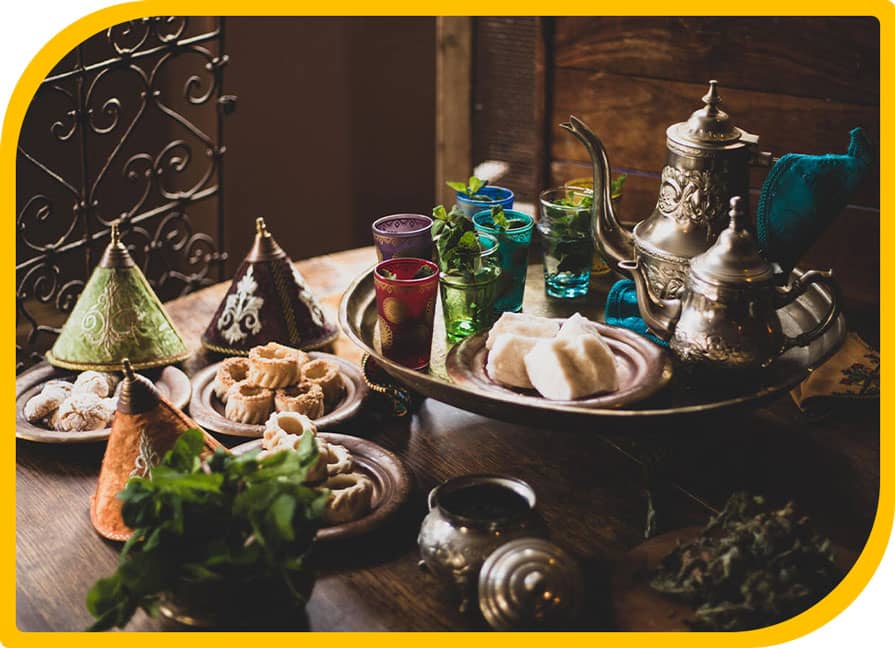
A. The Art of Moroccan Mint Tea
Preparing Moroccan tea is an act of grace and tradition. The base is Chinese gunpowder green tea, to which fresh mint leaves and sugar are added. The tea is poured from a height into small glasses, creating a delicate foam that symbolizes respect and mastery. Every Moroccan family has its own method — some prefer it sweeter, others add herbs like wormwood or verbena for extra aroma.
This ritual of pouring, serving, and sharing tea is an integral part of Moroccan hospitality. It accompanies everything — from casual gatherings to formal ceremonies — and, of course, it’s the perfect partner for sweets.
B. A Perfect Pairing of Flavors
Moroccan tea’s sweetness and minty freshness beautifully balance the richness of traditional desserts. The combination highlights the harmony of Morocco’s flavor palette — where sugar, spice, and herbs coexist in perfect balance.
Here are a few classic pairings:
-
Chebakia and Mint Tea: The honey and sesame flavors of Chebakia pair beautifully with the cooling freshness of mint tea — a Ramadan staple.
-
Kaab el Ghazal with Green Tea: The delicate almond filling and floral notes of gazelle horns are enhanced by the subtle bitterness of green tea.
-
Ghriba with Verbena Tea: Crumbly shortbread cookies complement the lemony aroma of verbena, offering a light yet fragrant pairing.
-
Baghrir with Cinnamon-Infused Tea: The buttery texture of Baghrir absorbs the spiced sweetness of tea perfectly — an ideal afternoon treat.
C. More Than a Drink: A Social Experience
Tea time in Morocco is about much more than refreshment — it’s about connection. Families gather around silver trays adorned with teapots, glasses, and small plates of Moroccan desserts and sweets. Conversations flow, laughter fills the air, and time slows down. To share tea is to share a moment of friendship and peace — an unwritten rule of Moroccan life.
In Moroccan culture, refusing tea is almost unthinkable. It’s an offering of warmth and welcome, and to sip it alongside sweet pastries is to truly experience the Moroccan way of living: slow, generous, and heartfelt.
D. The Final Sip
The partnership between tea and desserts captures the essence of Morocco — a balance between strength and sweetness, tradition and pleasure. Whether you’re in a bustling Marrakech riad or a quiet mountain village, a pot of mint tea and a plate of sweets remind you that life’s best moments are often the simplest ones — shared with others over something sweet.
Where to Try Moroccan Desserts
One of the joys of visiting Morocco is tasting its incredible variety of desserts and sweets in their authentic settings. From family-run bakeries hidden in ancient medinas to elegant cafés blending Moroccan and French influences, every corner of the country offers a sweet experience worth savoring. Whether you’re wandering through the streets of Fes or relaxing by the ocean in Essaouira, here’s where you can indulge in Morocco’s most beloved treats.
A. Traditional Souks and Medina Bakeries
The best place to start your dessert journey is right in the heart of Morocco’s old cities — the souks. In cities like Marrakech, Fes, and Chefchaouen, the air is filled with the irresistible aroma of honey, toasted almonds, and freshly baked pastries.
Look for small stalls selling:
-
Chebakia and Sellou during Ramadan
-
Kaab el Ghazal wrapped in paper or displayed in glass cases
-
Ghriba cookies baked fresh each morning
Bakers here often use recipes passed down through generations. You’ll not only taste authentic flavors but also witness the passion and pride that define Moroccan craftsmanship.
B. Modern Patisseries and Cafés
In larger cities like Casablanca, Rabat, and Marrakech, Morocco’s dessert culture meets modern sophistication. French-style patisseries offer an elegant setting where tradition and innovation come together. You’ll find:
-
Honey mille-feuilles infused with orange blossom
-
Almond croissants made with Moroccan honey
-
Pistachio tartlets and rosewater macarons
These cafés are perfect for travelers who want to enjoy the local sweetness with a touch of refinement. Try spots like Pâtisserie Bennis Habous in Casablanca — one of Morocco’s oldest and most iconic pastry shops — or Amandine in Marrakech, known for its luxurious Moroccan-French creations.
C. Riads and Traditional Guesthouses
Staying in a riad (a traditional Moroccan house with a courtyard) offers another unforgettable dessert experience. Many riads serve homemade pastries during breakfast or afternoon tea. Imagine sitting under orange trees, sipping mint tea, and savoring Baghrir, Kaab el Ghazal, or Fekkas — freshly prepared that morning.
Some riads even organize cooking classes, where guests can learn how to make classic Moroccan desserts and sweets from local chefs, using family recipes and time-honored techniques.
D. Street Markets and Local Festivals
If you want to taste Morocco’s desserts the way locals do, explore street markets and seasonal festivals. During Ramadan, vendors set up colorful stands selling trays of Chebakia and Zlabia after sunset. In desert towns like Erfoud, you’ll find sweets made from fresh dates during the annual Date Festival, while in the north, citrus-based treats are popular during harvest time.
These open-air experiences let you discover the regional diversity of Moroccan sweets — and enjoy the country’s festive spirit at its most vibrant.
E. Cooking Schools and Culinary Tours
For travelers who want to do more than taste, Morocco’s culinary schools and food tours offer hands-on opportunities to learn the art of dessert-making. Cities like Marrakech and Fes host professional and family-run workshops where you can prepare Chebakia, Sellou, or M’hanncha yourself. It’s not just about cooking — it’s about understanding the rituals, ingredients, and patience behind every dessert.
From humble medina bakeries to modern patisseries, Morocco offers endless ways to explore its sweet traditions. Each bite tells a story — of family, celebration, and history — making Moroccan desserts and sweets one of the country’s most delicious cultural treasures.
Tips for Making Moroccan Desserts at Home
Bringing a taste of Morocco into your own kitchen can be both rewarding and fun. While traditional Moroccan desserts and sweets often require patience and care, a few simple tips can help you recreate their magic — from honey-drizzled pastries to almond-stuffed delights. Here’s how to get started:
A. Stock Up on Essential Ingredients
Authentic Moroccan desserts rely on a handful of key ingredients that define their flavor and texture:
-
Almonds and other nuts: Whole, blanched, or ground, almonds are the backbone of many pastries like Kaab el Ghazal and M’hanncha.
-
Honey: Use pure, fragrant honey — ideally orange blossom or wildflower — for soaking pastries like Chebakia.
-
Orange Blossom Water: Adds a subtle floral aroma that is essential for most Moroccan sweets.
-
Semolina and Flour: Semolina is used for Baghrir and Makrout, giving a unique texture.
-
Spices: Cinnamon, anise, nutmeg, and ginger are common in doughs and fillings.
-
Dates and Figs: Essential for date-filled pastries or energy-rich sweets from the south.
Having these ingredients on hand will make your homemade Moroccan desserts taste closer to the originals.
B. Follow Techniques Carefully
Texture is crucial in Moroccan sweets:
-
Chebakia should be crisp but chewy inside.
-
Ghriba cookies should melt in your mouth.
-
Baghrir pancakes need those signature “thousand holes” to absorb honey and butter perfectly.
Pay attention to dough resting times, frying temperatures, and layering methods. Small steps, like rolling the filo thinly for M’hanncha or folding pastries carefully, make a huge difference.
C. Start with Beginner-Friendly Recipes
Not all Moroccan sweets are equally complex. Start with:
-
Ghriba: Simple shortbread cookies that are lightly sweet and quick to bake.
-
Baghrir: Pancakes made from semolina; fun to make and perfect for breakfast.
-
Fekkas: Twice-baked biscuits that require minimal ingredients but deliver great flavor.
Once comfortable, move on to more intricate recipes like M’hanncha or Chebakia.
D. Embrace Patience and Tradition
Moroccan desserts are often a labor of love. Don’t rush the process. Many recipes call for resting dough, slow frying, or careful assembly. Remember, part of the magic is the ritual itself — rolling, shaping, and soaking in honey is as much a part of the experience as eating the sweet at the end.
E. Pair with Tea for Authenticity
To fully capture the Moroccan experience at home, serve your desserts with:
-
Traditional Moroccan mint tea
-
Fresh herbs like verbena or spearmint
-
Small tea glasses to mimic the presentation
This combination not only enhances flavor but also creates the warm, welcoming atmosphere that is central to Moroccan dessert culture.
By following these tips, you can recreate the flavors and traditions of Morocco in your kitchen. Even if you’re miles away, a plate of homemade Moroccan desserts and sweets brings the magic of Moroccan hospitality right to your table.
Conclusion
Moroccan desserts and sweets are far more than just treats — they are a reflection of the country’s rich history, diverse culture, and warm hospitality. From the bustling souks of Marrakech to the tranquil riads of Fes, every dessert tells a story: of centuries-old recipes, regional ingredients, and the artistry of generations of bakers and home cooks.
These sweets are not only delicious but also deeply symbolic. They celebrate life’s special moments, from religious festivals and weddings to casual gatherings with family and friends. Whether it’s the honey-coated Chebakia, the almond-filled Kaab el Ghazal, or the spongy Baghrir pancakes, each dessert embodies Morocco’s spirit — generous, fragrant, and full of joy.
Trying Moroccan desserts is a journey for the senses: the delicate crunch, the aromatic spices, the floral hints of orange blossom, and the comforting sweetness that lingers long after the last bite. Paired with traditional mint tea, these treats transform a simple moment into an experience of connection, celebration, and pure pleasure.
For travelers and food enthusiasts alike, exploring Moroccan desserts and sweets is an invitation to dive deeper into the heart of Morocco itself. Each bite offers not just flavor, but culture, history, and tradition — a truly unforgettable taste of the Moroccan way of life.

